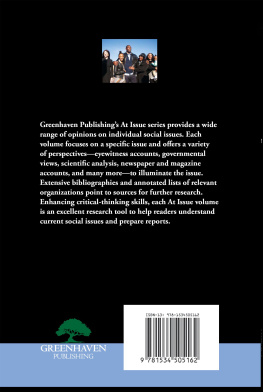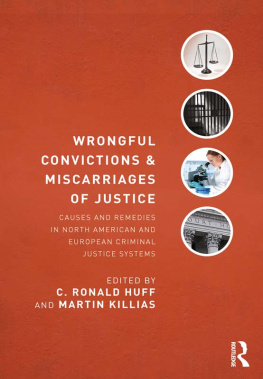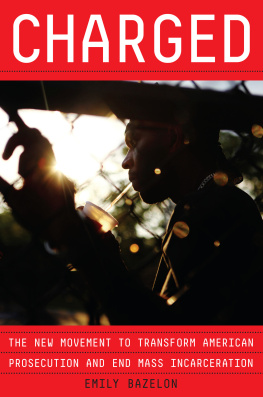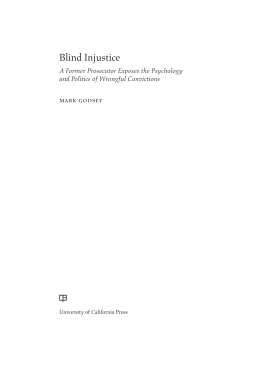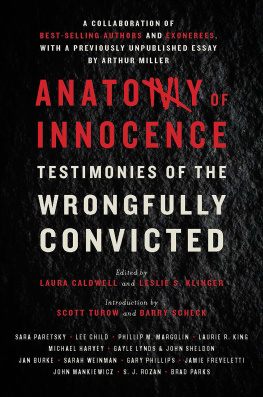Table of Contents
Pagebreaks of the print version
Guide

This book is dedicated to Kash Delano Register and Wilma Register, and was written in loving memory of my grandfather, the Honorable David L. Bazelon, the author of many groundbreaking and prescient judicial opinions, including the concurrence in United States v. Telfaire.
Authors Note
THIS IS A WORK OF NONFICTION . Names have been changed only where necessary to protect the anonymity of the sexual assault survivors who did not consent to have their full names or actual names used. In these instances, they are referred to by a first name only. Unless otherwise noted, the quotations and descriptions in the book come from interviews conducted by the author with the people who are described and quoted. Whenever possible, the information they provided was corroborated by individuals with personal knowledge of the events, court records, emails, photographs, letters, newspaper accounts, and media reports.
INTRODUCTION
Why I Wrote This Book
I WENT TO LAW SCHOOL because I wanted to be a very specific kind of lawyer.
I wanted to be a public defender. The transgressions of the wealthy never interested me much because their privilege guaranteed them access to the best possible lawyers. It was the poor and resourceless who stood to lose the most because the deck was stacked against them and always had been. No matter how heinous the accusation, they needed a fighter.
When I was twenty-seven, I landed a job at the office of the federal public defender in Los Angeles. My first day was November 5, 2001. I showed up with my hair twisted in a tight knot, wearing the new suit my mother had helped me pick out. Stiff and awkward in too-tight heels, I did my best to look like someone who could walk into an austere marble courtroom and try a case. I had no idea what I was doing.
I gradually learnedsometimes painfully and in public. With time, I got better and, finally, even very good. For seven years, I represented men and women of every race, ethnicity, and nationality. Some of my clients came from Compton or Watts; others from countries I had never heard of, speaking languages I didnt know existed.
Before moving to Los Angeles, I pictured a city out of the pages of US Weekly: white beaches, sprawling estates, glittering movie premieres, and the possibility of a celebrity sighting at every Starbucks. Needless to say, that was not the world I inhabited. The packed, buzzing arraignment court where I spent most Monday mornings housed dozens of suspected criminals who were the citys hidden faces, the ones most of us take pains to avoid seeing.
When people asked me what I did for a livingat parties, waiting to board a plane at the airport, on a datemy answer was sometimes met with a look of barely concealed distaste. One law professor, after requesting that I speak to a class of first-year law students, opened the question-and-answer portion by asking: How can you spend your days defending scumbags?
Here is the answer: my clients were not all angels, but they were human beings just like the rest of us. They had husbands, wives, boyfriends, girlfriends, children, and grandchildren. For some of the younger men, the gang was their family and violence was a basic means of communication. Some had serious addictions to alcohol, drugs, gambling, or the thrill of getting over on other people. Others were mentally ill. Many had been abused. All of them were desperate. Whatever money or luck or goodwill they once possessed was long gone.
Their lives could not have been more different than mine or, I suspected, most of the law students the law professor had asked me to address that day. But what I tried to get across thenand believed to the marrow of my boneswas that there was a powerful connection between my clients and me. At the end of the day, it was just the two of us, up against the seemingly infinite resources of the government.
I loved my public defender life. The work felt important. It was also fast paced and exciting. The stakes were high. In the cases that went to trial, I worked constantly and thought of nothing else, inhabiting a closed-off world so fraught and churning it often made me physically sick. But as a moral matter, the universe was simple and binary. There are alwaysand onlytwo irreconcilable sides of the same story. Black/white. Right/wrong. Feller/fallen. Beginning/end. Next case.
I left the federal public defenders office in 2008. By then, I was in my midthirties and in a serious relationship. I wanted to have children. While many women in my office were able to strike that balance, I did not believe I could. For seven years, my job had consumed me. I did not know how to do it any other way.
It was five years before I returned to criminal defense work, this time as the director of the Loyola Law School Project for the Innocent in Los Angeles, a free legal services clinic founded by Professor Laurie Levenson and staffed by law students that is dedicated to freeing the falsely convicted. It was inspired by the Innocence Project, a nonprofit organization founded by attorneys Barry Scheck and Peter Neufeld in 1992. Based in New York City, the Innocence Project litigates wrongful conviction cases across the nation and has freed more than two hundred innocent men and women from prison. Its success has spurred the creation of a network of nearly seventy similarly named organizations around the world that are dedicated to the same mission. The transformational effect of this advocacy on individual lives and on the publics perception of the criminal justice system has created an innocence movement.
At Loyolas Project for the Innocent, we had a client with the improbable name of Kash Register. In 1979, Register, who is black, was convicted by an all-white jury of murdering an elderly white man. Register was eighteen years old, with a new job and a baby on the way. He spent the next thirty-four years in prison for a murder he did not commit. Litigating his case, I slipped into my public defender mind-set: my focus was on how to marshal the evidence and arguments necessary to win in court. And we did win, by proving that a toxic combination of false testimony and misconduct by the police and prosecutors resulted in a conviction that was based on nothing but lies. After more than a year of litigation and a two-week evidentiary hearing, Register was exonerated on November 7, 2013.
But unlike my public defender work, Registers case did not end. Yes, the legal wrangling was over, but then there was the rest of his life to consider. His mother, Wilma, a woman of unshakable Christian faith, remained in the apartment where they had lived together when he was arrested. But Wilma was in her late seventies, still working full-time selling concessions at LAs Staples Center and barely getting by. Register needed a job. He needed clothes. He needed to reconnect with his thirty-four-year-old daughter, who had been born while he was in jail, and meet her two childrenhis grandchildren. He needed good civil lawyers who would sue the police and the city for every dime they owed him. He needed to learn to navigate a world that was unrecognizable from the one that was snatched away from him in 1979. He needed to heal from the psychic damage of being locked away from society for most of his life when he had done nothing wrong.
A few months after the exoneration, I received an email from a man named Bob Pool. The message began, I read of the liberation of Mr. Register with the help of your project. I am both elated for him and personally shaken. I was a member of the jury that voted to convict him so long ago. To find out that we were betrayed by the judicial system while tasked with one of the most difficult decisions in our (my) lives disgusts, sickens and saddens me. Pool said that his faith in law enforcement had been utterly destroyed. He concluded, I am trying to come to a personal resolution about this affair.



